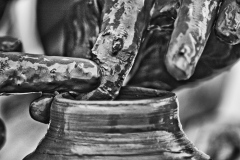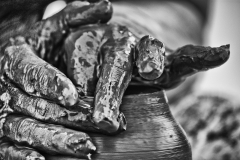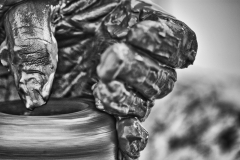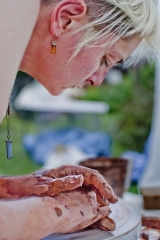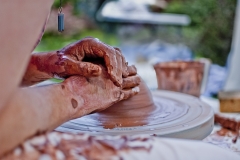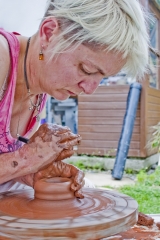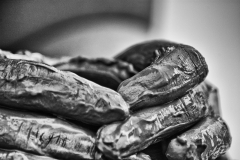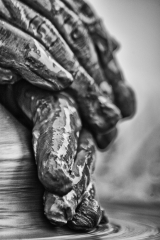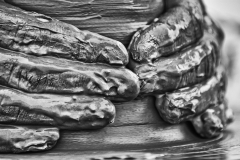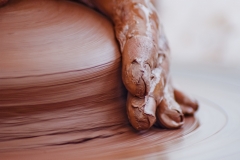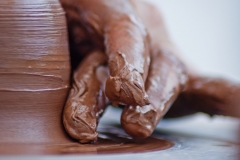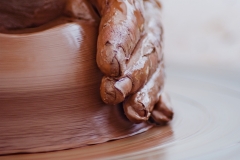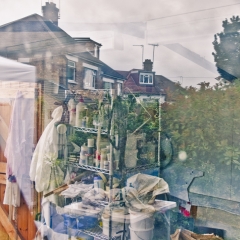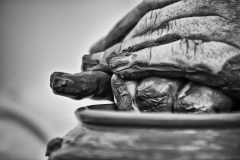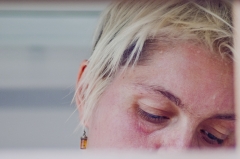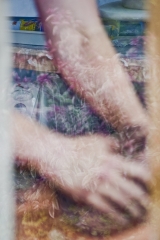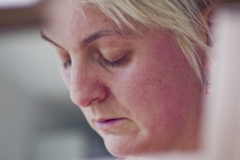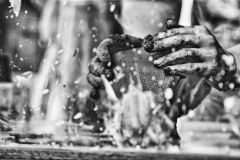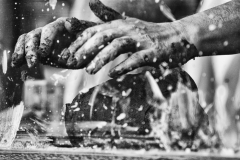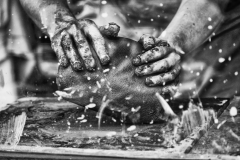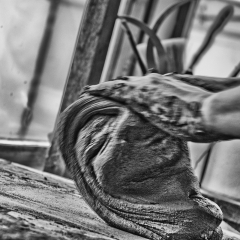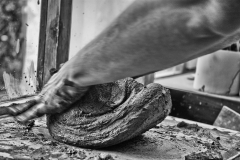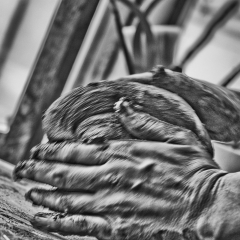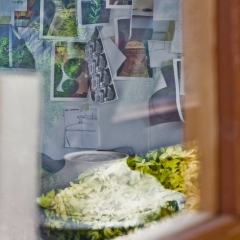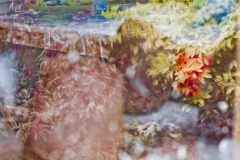We are sitting next to a shed in a backyard behind a family home in the northern suburbs of London. Although enclosed with fences to board off neighboring yards, it does not establish any sense of private space, as windows from around prey down on what is happening here. Looking up, I wonder whether people watching us realize why this shed is set up, amidst this sea of suburban profanity. Nobody might even wonder, as nothing special is expected down here, since creating the extraordinary seemingly demands extraordinary circumstances in support. Unsurprisingly, the art created in this environment is made from an inner inspiration that is not a result of the surroundings but is instead silently transforming the world it is brought into. Just as Sarah Core‘s ceramics does not need a sanctuary for making, it neither demands pedestals for showing. This is why Sarah’s art is so much affecting the life it has been nurtured from.
Asked how she came to ceramics, Sarah has told me that she chose ceramics over fine art because creating in ceramics requires a transformation and completion of an idea. While some fine arts projects seem to repeat the same issues over and over again without ever achieving a resolution, ceramics as a medium provides and requires this resolution by its material and tradition: First, the material in its volatility prevents any repetition and makes every piece unique, such that each piece embodies the moment of its very creation and the condition of the artist in making. And second, traditional work in ceramics is finished to purposeful objects. To this end, the tradition establishes a set of criteria to define a completed piece, like watertightness or proper decoration. With its roots in craft, the tradition in ceramics is much more intact than in many other fine art domains and Sarah exploits this strong frame as a point of reference in her work.
As a completed transformation, each piece becomes an emotional and creative relief as much as a starting point to begin anew. Since the material is unique in every single moment and the artist is changing during making, each repetition will be different. Sarah’s cultivation of this repeated difference is rooted in a very personal approach to art, spirituality, and healing. Therein deeply sincere, her work reaches well beyond postmodernist strategies — first, by revitalizing a modernist past which has celebrated creativity as a spiritual act, and second, by venturing into a new era of intense but grounded making.
transformation in clay
Working with clay means to facilitate the transformation of raw clay into finished ceramic: The clay needs to be wedged in order to squeeze out bubbles and align the platelets which are responsible for its plasticity. During this preparatory work Sarah becomes silent and focused. The clay is rolled and thrown on a wooden board by “rams’ heads” to form a lump of even consistency. The throwing on the wheel gradually refines the shape of the clay, starting with a quick wheel becoming subsequently slower. First, to center the lump, Sarah uses her whole body, anchoring her arm in, to push the clay towards the center, forming a tall, thin tower. When Sarah finally opens the lump, she searches with shut eyes for the unmoving center of the clay. Once found, Sarah pushes into the clay to form the base of the pot in becoming. After that, Sarah lifts the clay to the desired height, feeding the rising walls and the final narrowing from the thick clay at the base. This step seems to require most balance, since the upper clay is thinner and much more fragile, such that the centrifugal force would cause the little pot to break over any unbalances within the clay. At last, after fixing some details, Sarah cuts the pot off the wheel with a wet wire. Put onto a little board, the pot is left for drying, while awaiting decoration, burnishing, and firing.
In the process, Sarah is firstly very close to the clay, barely looking at it while searching for a tactile response, to be guided in finding the right shape. Gradually over time, when the rough outline emerges, Sarah becomes more distanced to overlook the piece in its entirety. Sarah works continuously and evenly paced, never stepping back or repeating anything. Thus the piece is the result of a single flow that incorporates the particularities of the clay as well as Sarah’s relation to the piece and the material. The most challenging aspect in all of this is the unpredictability of clay. For example, when it shrinks during firing, depending on thickness and quality, each spot shrinks at a different rate. Beyond understanding these differences, Sarah has to feel the character of the material at hand to judge its expected behavior in the kiln. Because it has “a life of its own”, clay cannot be forced into arbitrary shapes but must be understood and respected. This respect for the material and — in extension — for her own doing is fundamental to Sarah and her artistic practice.
Before drying and firing, clay is a very volatile material that is unforgiving in its sensitivity to the shaping hand. The leeway for corrections is marginal, such that errors often require a complete restart, as the clay needs to be wedged once more into a coherent and consistent quality — thus each piece is the result of a single flow of work. Later, when the fired clay has become hard like stone, it leaves no margin to hide any mistake made before. So the clay between Sarah’s hands is at first unstable and vulnerable and hence less in a single state than in continuous transformation. Once this flow is fired into stone, it becomes a manifest transformation.
completion in tradition
Sarah has never questioned the decision to move into ceramics, as the material seems to fit her naturally. Even the second cornerstone of her practice, a sense of completion, is already asked for by the material itself, as clay only becomes persistent once it is fired. Beyond that, tradition in ceramics comes with a comprehensive and rigid sense of completion in asking for functional pieces which are fit for well-defined purposes. Sarah exploits this notion of completion, but quite unsurprisingly, while her relationship with clay is harmonious, her position towards tradition is much more ambiguous.
This sense of completion in achieving a traditional shape has led Sarah to an interesting position: First, the common-day quality of traditional ceramics allows Sarah to position her work within the surrounding world, just like common objects made to serve our daily routines; talking about this, Sarah calls ceramics a “silent servant”. Second, Sarah pairs this exploitation of the craft’s innocence with a playful interpretation of traditional forms. Since these forms are often archaic, such as bowls or pots, they bear a multitude of meanings everybody relates to. In subverting these forms and installing the resulting works in our common lives, Sarah creates interventions like little acupuncture needles. Since Sarah does not aim at noisy, short-lived effects but lasting changes, she is shy to use the word intervention. Nevertheless, she envisions her pieces to return to the life they originated from, to change and inspire another creation: Completion is not an end by itself but the starting point of another piece, just like one step starts another one.
So while the craft with its well-defined shapes has brought Sarah to clay, it has also become Sarah’s angle for an artistic discourse on what constitutes a functional, useful, and healthy object in our post-industrial and post-postmodern societies. Instead of stripping her art from craftmanship, as to use clay as just another material in sculpture, Sarah is working at the boundary between craft and art. In order to deploy her objects within our daily lives, Sarah is rather bending the prescriptions of tradition instead of breaking them.
projecting between inner & outer
Among the projects Sarah has told me about, two stand out: First, a set of tableware sculptures reflects the notion of caring in their motifs and their mode of creation; and second, a ceramic pillow placed on a park bench plays with the concepts of interior and exterior space, as it seemingly belongs in a home while it proves to be not only weather-resistant but also completely impractical to sit on.
Each tableware sculpture consists of a number of pieces, such as plates, saucers, cups, and tea pots. The individual pieces follow traditional forms and would be functional, except for their arrangement into fixed sculptures. The tableware has a focus on its decorations which have been derived from paintings collected during a therapeutic workshop Sarah was offering. The attendees of the workshop were asked to paint an answer to the questions of what care is and how it feels to be a carer. After the workshop, Sarah covered her studio walls with the resulting paintings to use some motifs directly and to develop some further motifs from this inspiration. In condensing and integrating the individual paintings, Sarah arrived at three facets of care, namely support, structure, and flow, each leading to one of the three tableware sculptures. These three facets correspond to three colors and chakras, namely red, green, and blue for base, heart and throat chakra, respectively, all reflected in the three sculptures. With this approach, Sarah has created pieces about care in a most caring manner: First, in offering this workshop to the community, second, in thematising care during the workshop, and third, in curating the different paintings into coherent pieces (obviously enough, “curate” is derived from “cure” which is in turn derived from Latin “cura” meaning “care”). The theme of care is also reflected in the chosen techniques, playing with the concept of “bringing things to the surface” by decorating the tableware with paintings below and above the glaze. Also, some decorative elements seem to follow thin little cracks and emphasize the structure of the material underneath. By developing the pieces in a careful and caring process, the creation of the pieces has reflected back onto life, not only as pieces to look at, but by directly affecting the involved people. In this sense, the project has achieved completion and has been instrumental in a healing transformation.
In the second project, Sarah has not built upon traditional ceramic forms but instead created a ceramic pillow which proved to be a successful imposter. Put on a park bench, people walking by wanted to sit down on the seemingly soft piece that looked irritatingly alien under the open sky. The form of the cushion has been made to be literally hard to sit on. Beyond playing with perception and expected functionality, the cushion questions our concept of comfort and — related to that — the distinction between the outside and inside, as the latter should comfort us. This relation of the outer and inner world is another topic central to Sarah, as her multi-layered surfaces in the tableware already indicated. This time, she contrasts the protected and private inner space of a home with the exposed and public outer space of a park bench. Sarah’s interest in the connection between inner and outer originates from healing where inner processes are made visible and accessible in providing an outer correspondence. To achieve health, not only a mere connection is necessary but also a balance. The cushion, exposed to the outside but belonging to an inside, is irritating people for its imbalance. The question of comfort is closely related to healing, since comfort amounts to creating and curating an environment that matches our needs. Finally, healing is similar to art in that both relate the inner and outer world to make the inner world accessible and the outer world habitable.
Thus, both projects are examples of Sarah’s effort to establish a bridge between the inner and outer. This bridge can be seen as quintessential for a healthy and worthy life: Imre Kertész once wrote that fate arises in such a connection between inner and outer life. In his stories, this kind of fate is at the very essence of humanity in the face of most inhumane conditions. I like to believe that Sarah has come to ceramics not only because of the material with its transformation and completion, but also for creating hollow pieces as a meditation on their surface and the boundary that separates and connects the inner and outer world.
making with intuition
Interestingly, Sarah does not mention beauty at all, but describes her work in modest terms; she does not say what her pieces look like, or what they mean to her, but only whether they turned out well or not. The piece and its quality seem to come about as side-effects that are less planned than invited: Instead of realizing the pre-envisioned, Sarah wants to discover in making. This was after all one of Sarah’s reasons to move into ceramics — to manifest transformation in making.
When Sarah prepares the clay for throwing, she creates the potential for a multitude of different forms in herself and the material she works on. As clay becomes homogenous during wedging and ready to sustain plasticity, it bears a multiplicity of shapes: The possible extremes present in the clay span a wide range of distinct and heterogeneous shapes that are — at the same time — interpenetrating each other as the clay’s shape is evolving in an irreversible continuum. Although the shapes in the lump are morphing into each other, there is no shape that is ever repeatable, because of the ever changing clay. This multiplicity becomes a pure mobility during which no fixed shapes but only possibilities exist. Once in mobility, the making becomes indivisible, like any other movement that cannot be interrupted without ending it prematurely. In many creative processes, this is only experienced in an abstract manner, when the creative work collapses upon interruption. But in the case of ceramics, the material’s behavior itself requires a continuous transformation until reaching completion. For example, the wheel cannot be stopped at will, since the centrifugal force might be essential to the stability of the shape in becoming. Thus, upon entering this flow of shapes, Sarah is pulled into the process with an intensity that increases with the density and heterogeneity of the multiplicity until it discharges into the final piece.
This perspective on Sarah’s work is rooted in Henrie Bergson’s philosophy of creation which is probably most famous for the notion of the qualitative multiplicity outlined above as heterogeneous (many shapes coexist), interpenetrating (the shapes morph into each other), dualistic (the shapes span a wide variety between a number of opposing extremes), temporally progressive (the shapes change over time irreversibly), and continuous (the shapes are synchronically and diachronically united in one multiplicity). Bergson places such a qualitative multiplicity at the center of creation, as the source which yields the truly new: It is an essentially non-deterministic state that bears the potential for a multitude of shapes that differ in every moment from the shapes present before; thus upon entering the flow of the multiplicity, everything becomes new. The multiplicity itself is virtual and inexpressible, since every concrete expression is realizing the multiplicity in one of its potential forms, thereby causing its collapse. Bergson also explains in his method of intuition how we can reach such a qualitative multiplicity. In this method, one installs oneself in duration, which is another Bergsonian key term. This duration refers to experiences during which events are not juxtaposed as one after another: Instead, deeply involved in what we do, we experience time as something unmeasured — when we are immersed in what we do, we do not look for the time. Such an intense experience is changing us, since we make memories therein that change us forever, such that nothing done intensively can ever be repeated again. The more we immerse ourselves, the more we are surrounded by our memories and their echos, opening different possibilities to interpret the moment at hand. This is a duration which is by itself a heterogeneous continuum and thus a qualitative multiplicity. The question of how we can enter such a duration brings me back to Sarah and her clay: When she wedges the clay before throwing, she prepares not only the clay but also herself — the clay becomes homogenous and thus ready to sustain the plasticity of a multitude of shapes, while Sarah becomes sympathetic with herself, the clay, and — through that — with the world around her. This sympathy bears an intuitive account that exposes her to an heterogeneity of perspectives that installs her in duration: Instead of taking one perspective at a time, Sarah experiences a multitude of viewpoints while the measured time is left behind and the moment turns into a creative flow.
Consequently, Sarah describes herself during making as an instrument to the process which she is involved in but ultimately not controlling herself. For example, Sarah feels “surrounded by the wheel” which is in turn not a distant tool but an extension of herself. Sympathetic to the things around her, the environment she works in is extremely important, to the point that she feels to be created by her tools. Likewise, Sarah considers making as an act of self-creation and recreation, since each completed piece embodies her disposition: A piece obviously reflects the posture during making, the height of the wheel, which distance she takes, or the strength she applies. But at a more subtle level, Sarah experiences in the material and outward transformation a simultaneous, immaterial, and inward change.
The need for a completed transformation, the bridge between inner and outer, the sympathy towards oneself and in extension to the world around, and the experience of duration can all be seen as aspects of a healing approach that affects the inner being in unison with the outer manifestation in the created piece: After having survived a terrible accident, Sarah found in clay a way to transform her life within a continuous making practice.
sincerely engaged
My interpretation of Sarah’s work is replenished with Bergsonian terms. This is certainly rooted in my own interest in Bergson, but beyond that, his philosophy of creation does fit Sarah’s work extremely well for two reasons: First, Sarah attempts to bridge the gap between herself and the clay by not working the clay from the outside but from within the clay — seeking in Bergsonian terminology for sympathy with the material. Second, creating in such a sympathetic state, Sarah connects deeply with the material at hand and thereby establishes a bridge between the inner and outer world. This spiritual and sincere approach to making is essentially modernist — fitting the times of Bergson who was active in the late 19th century and the first half of the 20th century.
This turn to modernist approaches in Sarah’s work is not a particular but general development. With the end of postmodernism, maybe most explicitly stated by the retrospective in the Victoria & Albert Museum in 2011/12, the discussion on our current cultural disposition brought forth the notion of metamodernism. Metamodernism describes our culture as an oscillation between a modernist sincerity and a postmodern irony. Timotheus Vermeulen and Robin van den Akker, who have established metamodernism as understood today, associate metamodernism with story, engagement, sincerity, craft, and care (see their talk at A New Dawn from 2013) — which amounts to a blueprint for Sarah’s work which is obviously rooted in craft: While Sarah incorporates material from other people and refers to traditional forms — as in case of her tableware described before, she is not applying strategies like pastiche or collage in a postmodern manner; instead, she integrates the material into a coherent story to precisely overcome the ruggedness of our daily lives. Engagement and care are central to her work, both as a topic to be reflected upon and as a way of creating, when she is for example teaching at community workshops. And the sincerity in Sarah’s work is rooted in her belief that care can heal and better our lives.
pictures
The pictures below have been taken during a summer afternoon when Sarah has been creating a series of pots related to skin care, inspired by a late Minoan jar Sarah has discovered at the Ashmolean Museum. This jar was probably used for mixing oils and perfumes for ritualistic purposes. Taking this jar as a prototype, Sarah is creating a large jar together with an assortment of smaller vessels, each following the shapes of a plant used in skin care essences. Asked about this project, Sarah is much more careful in her words, not knowing what the project is really about until she has completed it to discover what she has done. However, the topic of care is obvious, and reflecting about it, Sarah recognizes this project as a more personal continuation of the tableware sculptures where she has incorporated the vision of care of so many other people. In any case, the principal lines of her artistic approach are well visible in this project: Sarah works here with traditional forms, neither simply adopting nor caricaturing them, but instead employing them for her ends as a rich language at her disposal, emphatic with the tradition but rooted in a very personal approach; also the topic of skin seems to be significant, as skin is mediating between the inner and outer, just as care and healing are central to Sarah as a core motivation driving her art.

